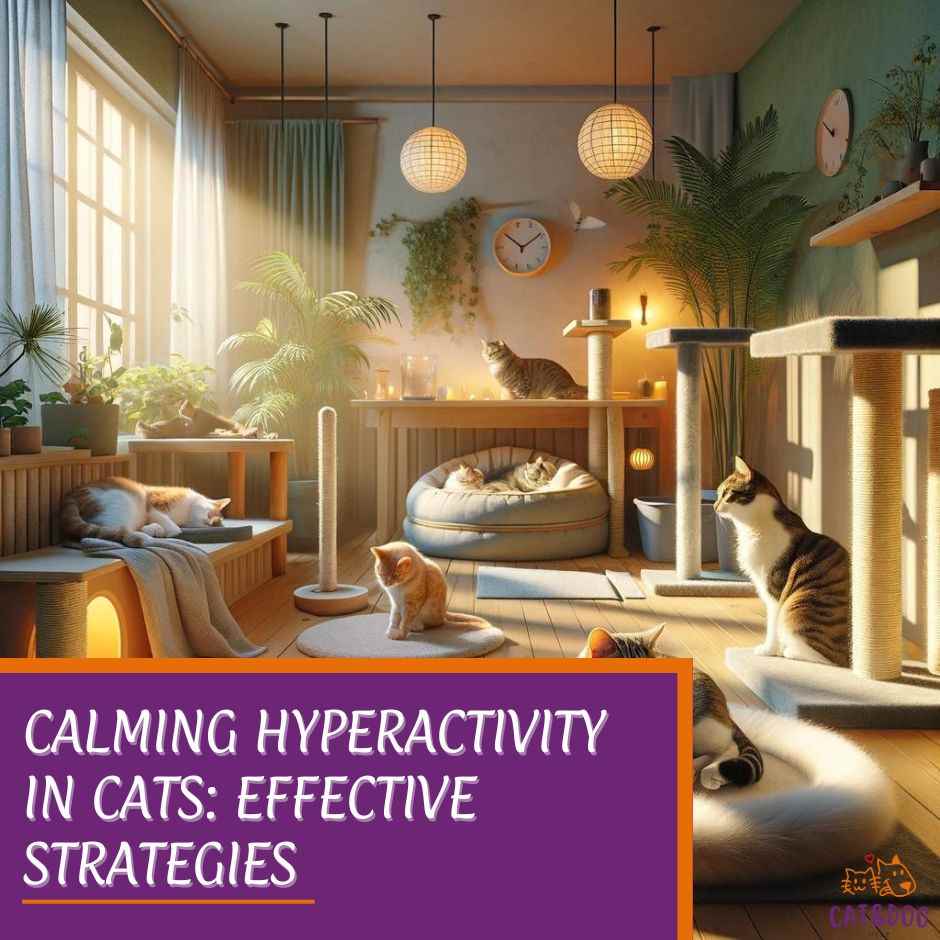Have you ever watched your feline friend zoom around the house at breakneck speeds and wondered if their energy levels are normal?
Cats are known for their playful antics and sudden bursts of energy, often amusingly referred to as the ‘midnight crazies.’
The causes of hyperactivity in cats can vary. It could be due to a lack of mental and physical stimulation, stress or anxiety, medical conditions, or even certain medications. (1)
It’s important to consult with a veterinarian to determine the underlying cause and develop a plan to manage your cat’s hyperactivity.
It’s important to differentiate between a cat’s natural vivacity and genuine hyperactivity, which can be a cause for concern.
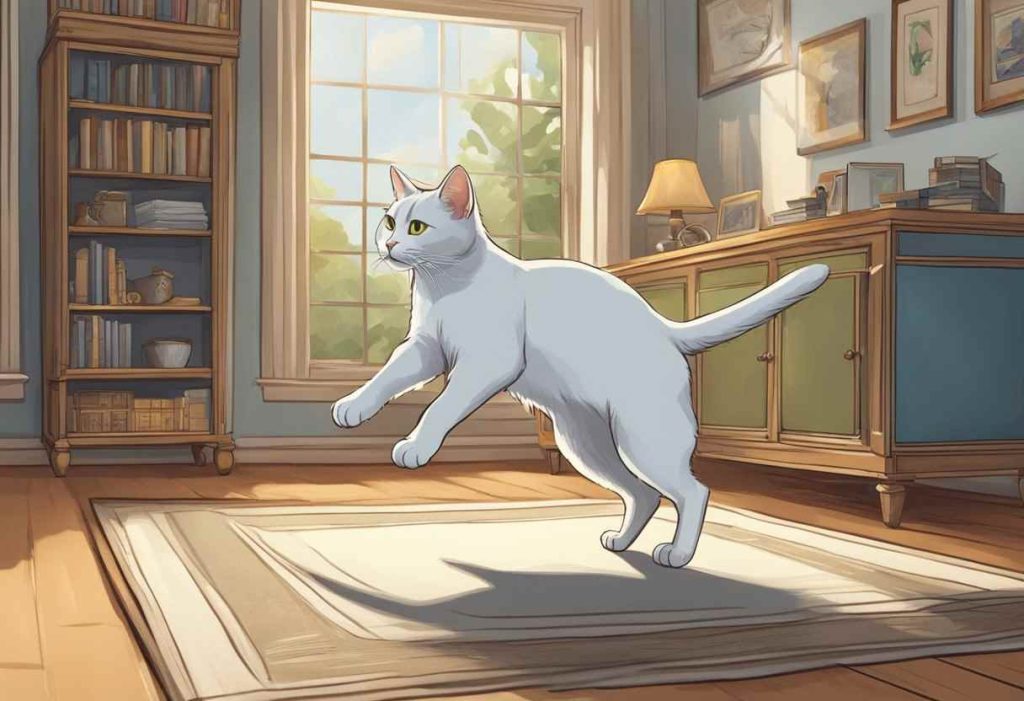
Hyperactivity in cats can manifest in various forms, including excessive playfulness, aggression, or an inability to remain still. (2)
Understanding the underlying causes of this behavior is crucial, not only for your cat’s well-being but also for maintaining a harmonious household.
This behavior can stem from environmental factors, medical issues, or even their breed.
It’s essential to recognize the signs early to manage them effectively. Caring for a hyperactive cat can require extra attention and specific strategies.
From creating a supportive environment with ample stimulation to seeking advanced behavioral and medical interventions if needed, being prepared can make all the difference.
Let’s explore some practical solutions and when it might be time to consult a professional about your cat’s effervescent energy.
Key Takeaways
- Hyperactivity in cats can be a sign of playfulness or an underlying issue needing attention.
- Recognizing and managing hyperactivity includes environmental changes and possible veterinary interventions.
- Preparation and support are vital for living with a hyperactive cat, including community advice and appropriate products.
Practical Solutions for Managing Hyperactivity in Cats

Daily Play and Environmental Enrichment
First things first, you’ve got to channel that energy! Regular play sessions are a must.
Think about engaging toys like:
- Laser pointers: A red dot sprint can exhaust the most spirited sprinters.
- Feather wands: Perfect for those aerial acrobatics.
Transform your home into a feline paradise with climbs and hideouts:
- Cat trees for the climbers
- Boxes for the hiders
Dietary Adjustments and Supplements
You are what you eat, and that includes your cat. A balanced diet might just be the key to calm. Here’s the deal:
- High-protein meals satisfy that wild hunter instinct. (3)
- Consider calming supplements. A little valerian or catnip can go a long way!
Remember, these are starting points. Pay attention to how your cat responds, and adjust from there. Each furball is unique!
Recognizing When Hyperactivity Is a Problem
Cats are naturally playful, but sometimes their energy levels can signal something more concerning than a burst of playful spirit.
Normal Playfulness vs. Problematic Behavior
You know your cat is a spirited whisker wizard, but when does this tip into hyperactivity? Keep an eye out for:
- Non-stop activity: If your cat rarely sleeps or rests, and is constantly on the move, a vet check may be in order.
- Destructive behaviors: Shredded toilet paper again? When your cat’s antics turn destructive, it’s a sign they might need help burning that energy off.
When to be Concerned about Your Cat’s Activities
So, when should Little Whiskers’ midnight sprints concern you?
- When it’s affecting their health or yours.
- If it’s paired with aggression or a sudden behavior change. (4)
Consulting Veterinary Professionals
If you’ve ticked off some of the warning signs, it might be time to call in the pros. Here’s why:
- Vets can identify if it’s excitement or something medical.
- Diet, environment, and health all play a part – your vet can guide you.
Signs that It’s Time to Seek Professional Advice
What are the red flags saying “Vet ASAP”?
- Over-the-top energy: Even after playtime, if they’re bouncing off the walls, get a professional’s opinion.
- Change in routine: Is your cuddle buddy suddenly shunning snuggles for mad dashes? Time to ask why.
Causes of Hyperactivity in Cats
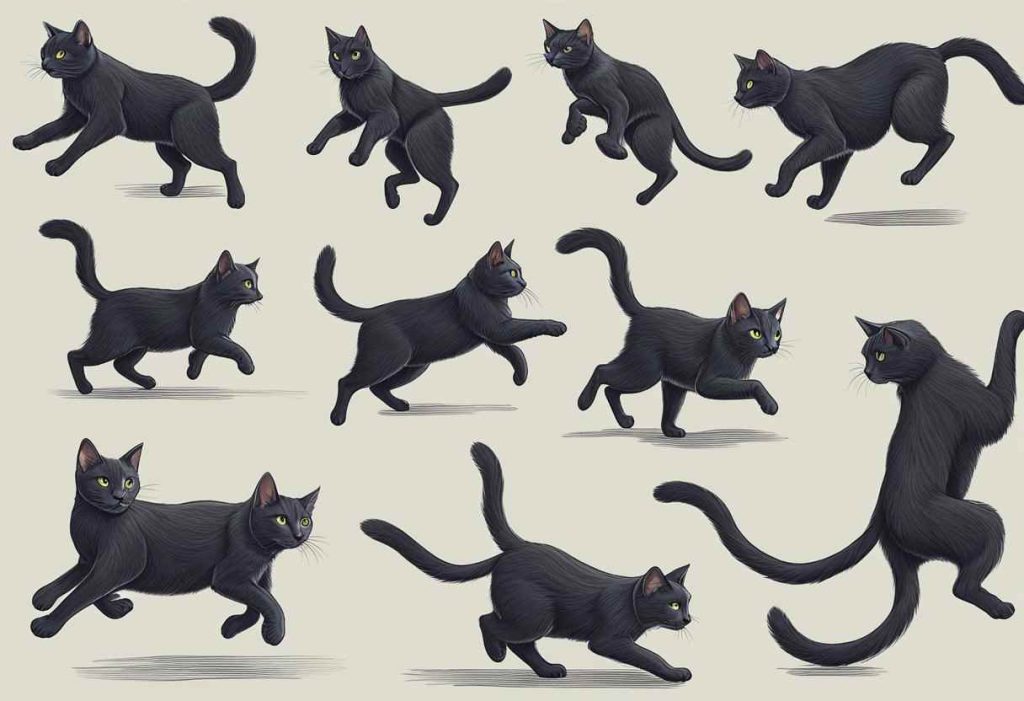
Psychological and Physiological Triggers
Ever noticed your feline friend zooming around at the speed of light? Cats can have bursts of energy that lead you to wonder, what’s fueling their fire? Let’s break it down.
- Boredom: Just like us, cats need stimulation. A lack of interactive playtime can lead to your kitty turning your house into their racetrack.
- Stress: Yep, cats get stressed too! Changes in their environment – say a new pet or moving houses – can trigger anxious energy.
- Hunting Instinct: Cats are natural predators, and their play mimics hunting behavior. Indoors, this can translate to hyper-activity.
Health Concerns Behind Hyperactivity
Hyperactivity isn’t always just high spirits. It could be a sign your cat needs a vet check-up.
- Hyperthyroidism: This condition revs up their metabolism, causing weight loss and hyperactivity.
- High Blood Pressure: Similar symptoms to hyperthyroidism, with possible restlessness.
- Medication Side Effects: Certain meds may have the unexpected side effect of making your cat more hyper than usual.
Has your cat suddenly turned into a sprinter, or are they persistently overactive? It might be time to consider a trip to the vet to rule out these health issues.
Behavioral and Medical Interventions
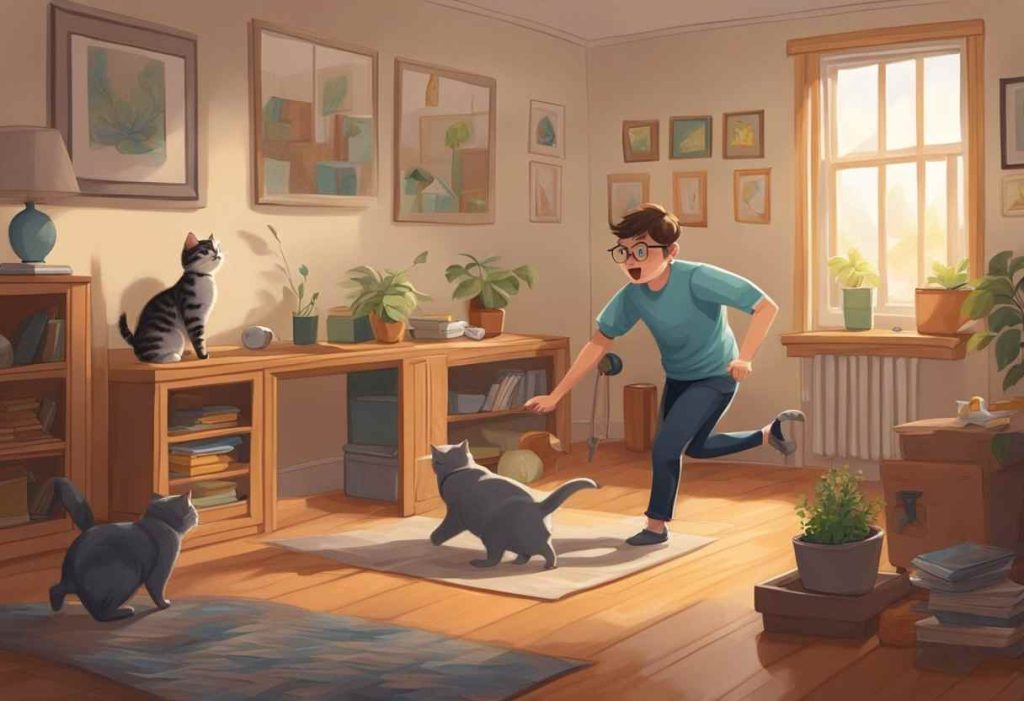
Professional Resources and When to Use Them
Have you ever thought about talking to a veterinary behaviorist? These pros are like the cat whisperers of the pet world.
They specialize in animal behavior and can offer tailored strategies to manage your furry friend’s hyperactive antics.
Behavioral Therapy:
Medication and Behavioral Therapy
In some cases, your vet might suggest medication alongside behavioral techniques.
Don’t worry; it’s not about sedating your kitty but more about finding a balance.
Common Medications:
- Antidepressants (7)
- Antianxiety drugs
- Specific calming agents
Remember, drugs are not a one-size-fits-all solution and should always be prescribed by a professional following a thorough evaluation.
Non-Pharmaceutical Treatments:
- Pheromone diffusers
- Specialized diets
- Therapeutic toys
The fusion of medication and behavioral therapy often leads to the best outcomes.
Imagine combining a well-structured playtime routine with a handy pheromone diffuser to keep the peace at home. That’s teamwork at its finest!
To Sum Up
When you notice your cat’s energy levels are off the charts, don’t fret! Getting the right help can make a world of difference.
With the right blend of medical and behavioral strategies, you and your whiskered dynamo can live in perfect harmony.
Preparing for a Hyperactive Cat

For Prospective or New Cat Owners
Have you just welcomed a furry whirlwind into your home or planning to? Let’s get you set up!
Finding a cat that matches your energy level is crucial. If you’re on the go, a spirited cat could be your perfect match. If not, consider a calmer breed.
Creating a Stimulating Environment
Setting up your space is key.
Cats love vertical territory, so invest in tall cat trees and shelves. This allows them to survey their kingdom from on high.
Interactive toys are a boon for keeping them engaged; think laser pointers and feather wands. Here’s a quick checklist:
- Sturdy cat trees
- Interactive toys
- Shelves for climbing
Early Behavior Training and Socialization
These aren’t just for dogs, you know!
Introduce your cat early to various experiences, from handling to playdates. A well-socialized cat is often a calmer cat. Let’s break it down:
- Handle your cat gently
- Introduce them to friends and family
- Schedule playdates with other cats (if safe)
Preventive Strategies to Manage Energy Levels
Now, we’re not talking about energy drinks here, but tactics to exhaust that kitty energy!
Frequent play sessions are your friend and puzzle feeders can turn mealtime into an engaging activity. Remember, a tired cat is a happy cat.
Remember to mix things up because cats, much like us, can get bored. A variety of toys and activities will keep things fresh – and might just save your curtains.
Building a Supportive Community

Online forums and local groups are buzzing hives of activity where you can find fellow cat owners sharing tips and tricks.
Engage With Support Networks – it’s a game-changer!
They’re goldmines of advice and can give you practical, real-world solutions. It’s where the proverbial cat wisdom is.
Have you tried an internet search for “hyperactive cat community”? You might be surprised by the number of hits you get!
These platforms allow you to:
- Share your own experiences
- Learn from others
- Find reassurance
- Discuss what works and what doesn’t
On these forums, you’ll read up on success stories that can bring a ray of hope when your furry friend is bouncing off the walls at 2 AM.
Real-life examples provide concrete evidence that you’re not alone and that there’s light at the end of the tunnel.
How about local groups?
Imagine having a cup of coffee with someone who understands your “Why is my cat running laps at midnight?” dilemma.
Local groups can offer:
- In-person advice
- Playdates for your cat to burn off excess energy
- Support from those who’ve been in your shoes
So, have you already picked out a username for the forums? Ready to meet your new coffee buddies? Balancing your cat’s hyperactivity may take a village, and thankfully, that village is closer than you think.
Say goodbye to feeling puzzled and hello to a world of support – it’ll be the cat’s pajamas!
Product Recommendations and DIY Solutions
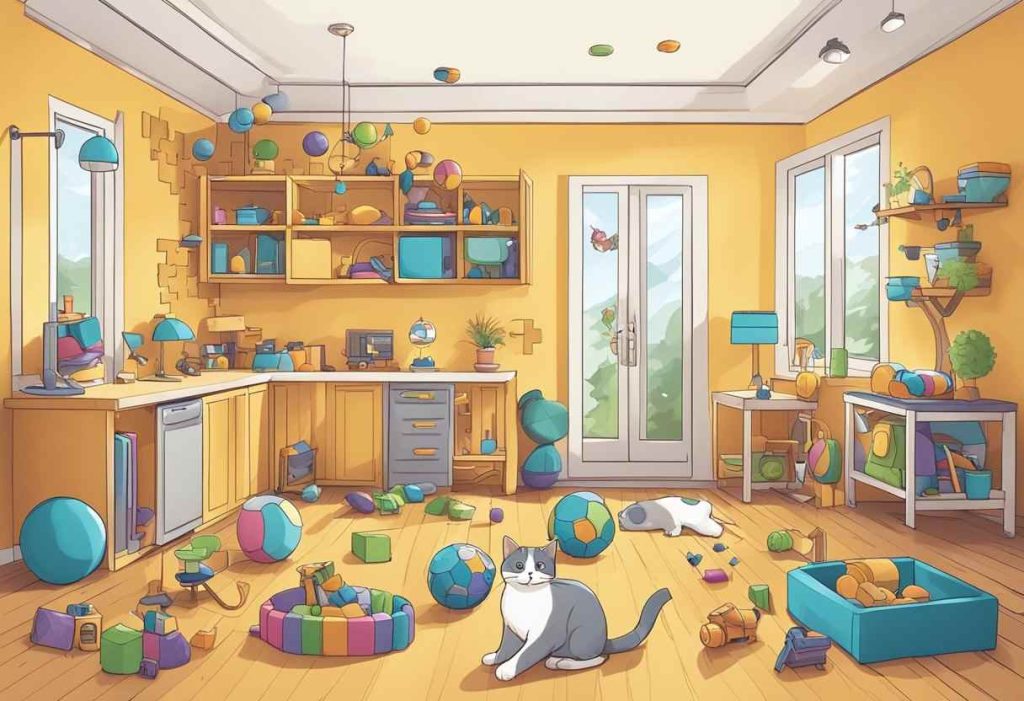
Tried and Tested Products for Hyperactive Cats
Stimulation is key. Here are a few top-rated items that cat owners swear by:
- Interactive Cat Toys: Think feather wands and laser pointers.
- Puzzle Feeders: These make your cat work for their treats!
- Scratching Posts: An absolute must to keep those claws busy.
| Product Type | Example | Why It Works |
| Toy | Motorized Chaser | Encourages chasing and pouncing. |
| Feeder | Treat Maze | Engages natural hunting instincts. |
| Furniture | Multi-Level Cat Tree | Provides climbing and perching opportunities. |
Don’t worry if you’re on a budget; sometimes, the best things in life are free—or homemade:
Creative Home Solutions
- Cardboard Boxes: A simple box can become an adventure fort.
- DIY Obstacle Course: Use cushions and tunnels to create a fun circuit.
- Homemade Toys: A crumpled paper ball can entertain for hours.
Just grab some common household items, and you’ve got an instant kitty playground! Remember, whether you buy or DIY, the goal is to keep those paws occupied and that mind engaged.
With a little creativity and some carefully chosen products, your hyperactive companion will be purring with contentment in no time! Have you picked their next favorite toy yet?
Quick Recap
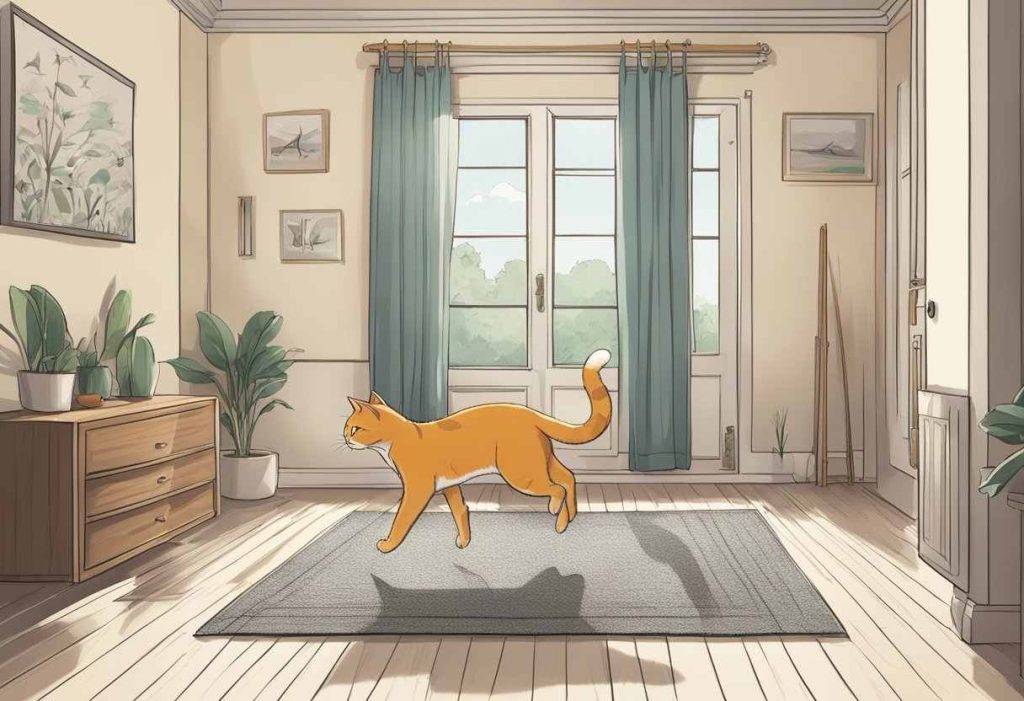
Hyperactivity in cats can stem from various causes such as genetics, environment, or diet.
What You Need to Know:
- Hyperactivity might be a result of your cat’s natural playfulness or a higher energy breed.
- An enriched environment with toys and playtime can help manage their energy levels.
- Dietary influences are crucial; certain foods may heighten your cat’s vim and vigor.
Have you considered these factors?
| Potential Causes | Solutions |
| Boredom | Increase playtime and enrichment activities |
| Excess Energy | Create a consistent exercise routine |
| Diet | Assess and adjust food intake, if necessary |
Tips for Managing Hyperactivity:
- Schedule regular play sessions.
- Introduce interactive toys.
- Consider puzzle feeders to engage their minds.
- Maintain a peaceful and stimulating environment.
- Visit a vet if you suspect any health-related issues.
Remember, a happy cat is an active cat.
By understanding their needs and making a few adjustments, you can ensure both you and your whiskered companion have a harmonious home.
Keep up the good work, and give your cat a little extra scratch behind the ears for us!
Frequently Asked Questions
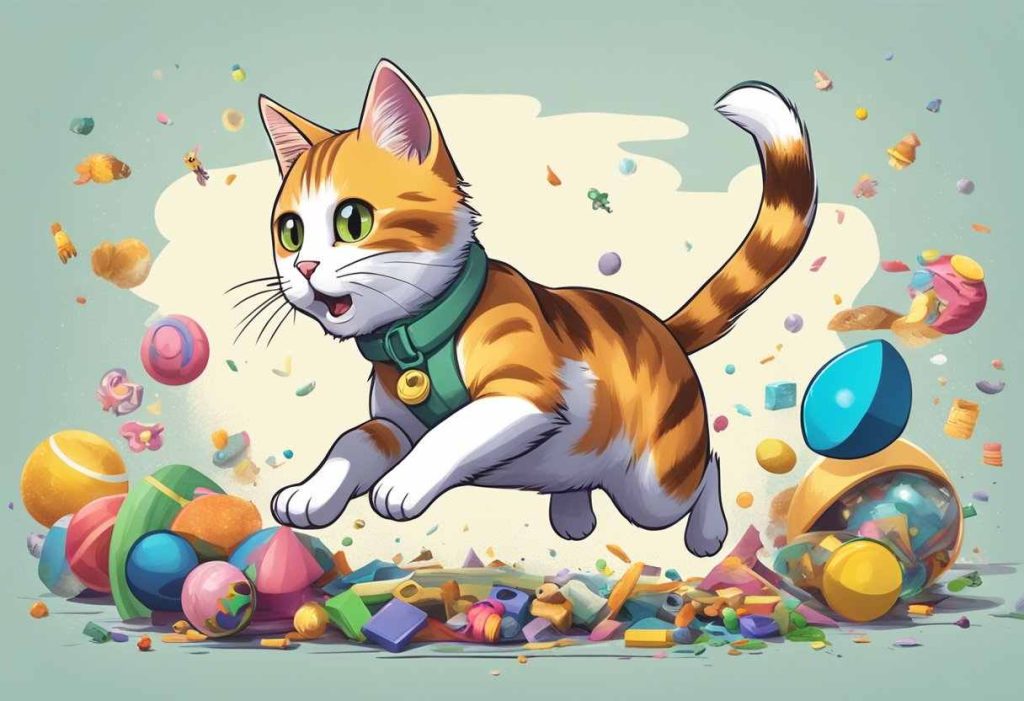
If you’ve noticed your furry friend zooming around the house more than usual, you might be wondering about their hyperactive behavior.
Here are the most common queries cat owners have about hyperactivity in their pets.
What are the common signs to look out for that indicate my cat might be hyperactive?
Look out for excessive jumping, running, or chasing imaginary prey. Your cat may also have trouble settling down and display a constant need for movement.
What are the first steps I should take if my cat suddenly becomes hyperactive?
Start by ensuring they have a safe environment to expend their energy. Check for changes in their routine or environment that might be causing stress.
How can I tell if my cat’s hyperactivity is due to boredom or a medical issue?
Boredom often leads to destructive behavior or attention-seeking.
If your cat is also showing signs of weight loss, vomiting, or diarrhea, it could be a medical issue, so a vet visit is in order.
What toys or activities are most effective for managing a hyperactive cat?
Interactive toys like laser pointers or feather wands can help. Puzzle feeders engage their minds while providing exercise.
How much playtime does a hyperactive cat need daily to manage their energy levels?
Aim for at least 20-30 minutes of playtime split across the day. Adjust based on how quickly your cat tires out.
Can diet affect my cat’s energy levels and behavior?
Absolutely! High carbohydrate diets can spike energy levels. Some cat owners find that a high-protein, low-carb diet might stabilize their cat’s energy.
Are there any natural remedies or supplements that help calm hyperactive cats?
Some owners have had success with natural supplements like valerian root or catnip.
However, talk to your vet before introducing any new remedy.

